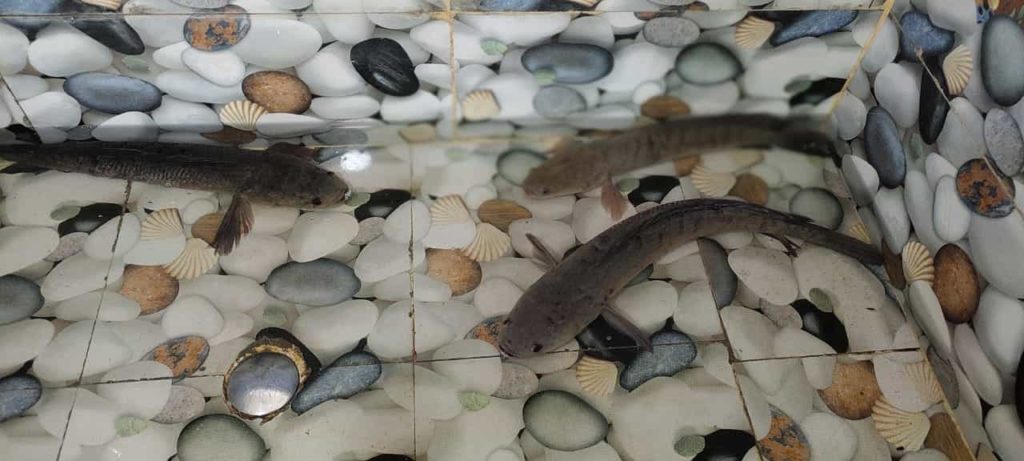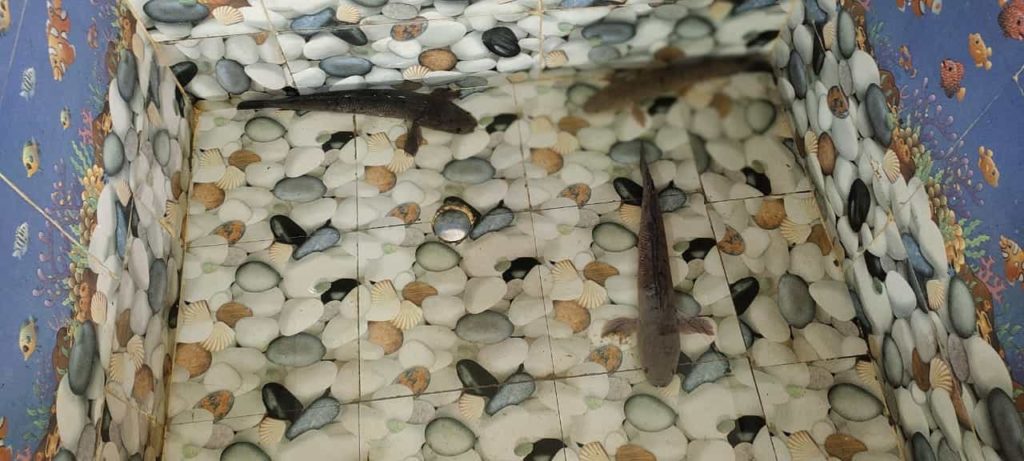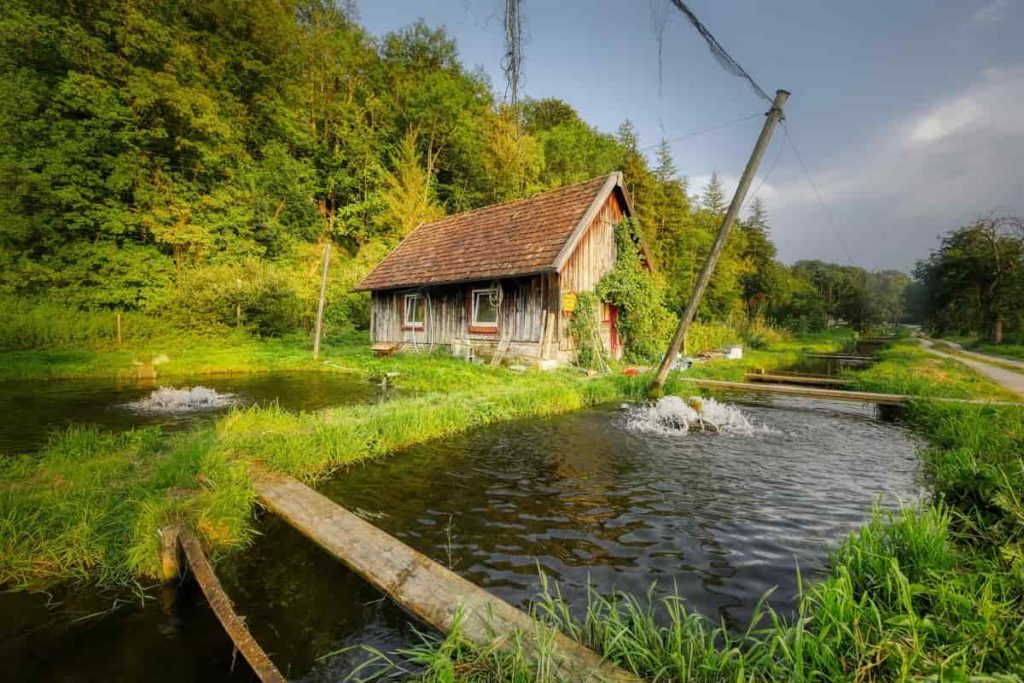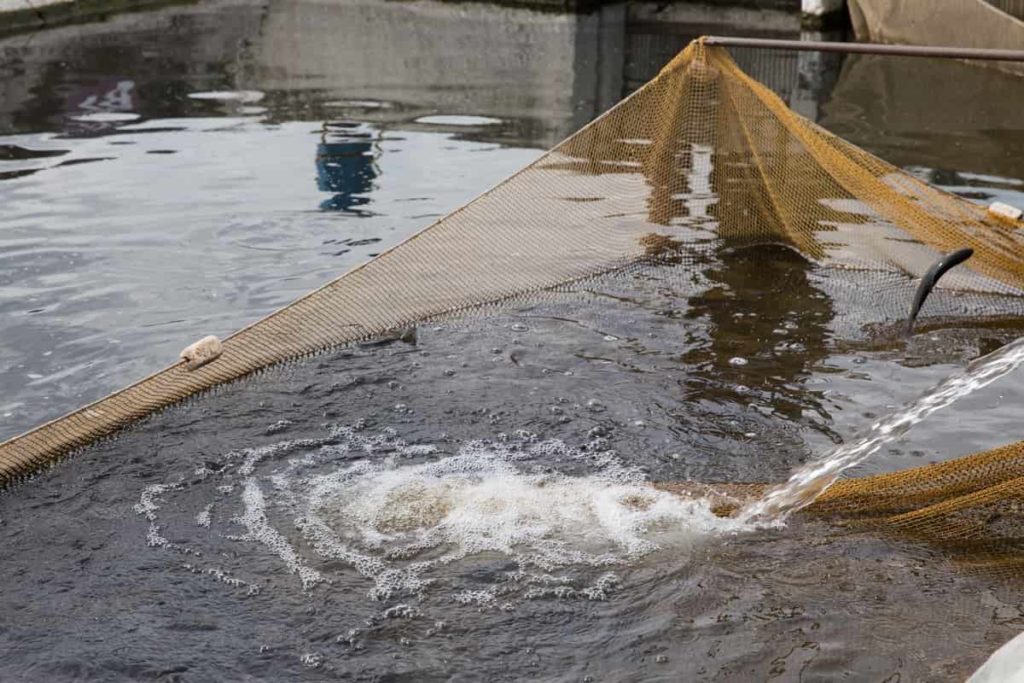Commercially rearing fish in tanks or cages for food production is known as fish farming. This is the most often used cultural system. The most prevalent species are freshwater prawns, catfish, and carp. The fish may simply be kept in tanks until they’re ready for market, avoiding the need to catch them in the wild. Farm-raised fish is both healthier and more flavorful. On commercial fish farms, fish are often fed a variety of nutritional diets.

The fish in a pond is not available to everyone. As a consequence, they are secure and may be selected at any time. To enhance revenue and improve water management, fish farming may be integrated into an existing farm. Commercial demand for wild-caught fish may not always be met; in certain circumstances, industrial fish farming may be able to cover the gap. Murrel fish is also called “Korramenu” in Andhra Pradesh and Telangana. Let’s find out how this farmer made 10 lakhs from his murrel fish farm.
How this farmer made 10 lakh from his murrel fish farm
The success story of Mr. Reddy
Mr. Reddy from Nalgonda has been raising Murrel (Korramenu) fish for 5 years. Special tanks and cement ponds have been set up for this purpose. The fish grow up to 7 kg in 7 months, after which they are marketed. Mr. Reddy said that a good income can be obtained if all the precautions are followed while growing them. He said the market for these fish would be stable and the income would depend on the care taken by the people who choose to grow fish.
Site preparation for Murrel fish farming
Mr. Reddy constructed a cement pond of 18*30 with 2 feet deep and 3 special tanks of the same storage for the cultivation of Murrel fish. These tanks and ponds have a capacity of 50,000 liters. These can store the fish seed of 1500 seedlings that are harvested when they acquire a weight of 800 grams. If we want to cultivate Murrel fish that are harvested at 1kg or above then the fish seed must be limited to 1000 seedlings.
While constructing the fish ponds, he said it is necessary, to install shed nets around the cement ponds and tanks, from this we can prevent fish from jumping out of the ponds. He also made three mud ponds with a depth of 6 feet, in 90 Guntas areas for the cultivation of fish. 1200 seedlings can be cultivated in these mud ponds and if the depth is 5 feet you should restrict the supply of seedlings to 1000, he expressed. You can also shift the fish to these ponds once the fish acquires a weight of 50 grams in the cement ponds and tanks.
In case you miss this: Murrel Fish Farming Project Report, Cost & Profits

He managed this one-time capital cost by using recycled materials that are available at a very low cost in the market. This capital cost is erased if we have our land. We can also take the land for lease if you want to get into the fish farming business for a short period.
Growing Murrel fish in concrete tanks and mud ponds
He says, if we cultivate Murrel fish in cement ponds and special tanks it takes 7 months to grow a weight of 800 grams per fish. If we want to harvest the fish at 1 kg then we have to take only 1000 seedlings per cement pond or tank as they grow to become 1kg in 10 months. A single Murrel fish takes an FCR (Feed Conversion Ratio) of 1.4 to grow 1kg which means we have to provide 1.4 kg of feed till harvesting so that it grows until it gains a weight of 1 kg. This FCR is appropriate only if we cultivate fish in tanks or cement ponds.
Fish take more amount of feed when cultivated in cement ponds or tanks this is because in artificial ponds there is no organic matter on which the fish can rely for food. You can also grow fish in large mud ponds. Fish that are cultivated in mud ponds are healthier than those that are grown in cement ponds. This is because fish can feed on natural organic matter such as worms and other pests that are available in the mud. We can either directly grow fish in ponds from the start or we can shift the fish from tanks or cement ponds once they acquire a weight of 50 grams to 60 grams.
FCR for the fish that are grown in mud ponds is 1.1 since it is also exposed to natural feed. Fish take less amount of artificial feed if they are grown in mud ponds hence decreasing our feed cost. There is an advantage of fish that are grown in mud ponds; fish takes less time to reach the desired weight. In mud ponds, Murrel fish can reach 1 kg in just 7 months whereas it takes 10 months in cement ponds and tanks.
If you want to cultivate fish from start in the mud pond system, for a few days you have to install a hapa in the mud pond. Hapa is a square net impoundment placed in a pond for holding fish until they reach a weight of 10 grams. Hapa is taken off once they reach this weight and are released into the whole pond for better development of Murrel fish.
In case you miss this: Fish Pond Setup Guide; Suitable Pond Fish Species

Feed management for Murrel fish in concrete tanks and mud ponds
Mr. Reddy stated from his experience that, the more we save the cost of fish feed the greater the profits are since a large amount of the running cost consists of feed cost. The feed given is different in various stages of its growth. Hapa feed must be given to Murrel fish while they are still in Hapa nets. When fish acquire a weight of nearly 200 grams the feed given is changed.
You have to fix a time to feed Murrel fish daily so that they get habituated to eat at a particular time, this is one of the underrated advice of fish farmers that keeps Murrel fish healthy in various stages of its growth. In his experience, Mr. Reddy learned that the feed required for cultivation in mud ponds is less than that of concrete tanks and the results are better in mud pond fish farming.
Caring for Murrel fish in concrete tanks and mud ponds
Mr. Reddy told, “Weight of Murrel fish is purely dependent on the care taken. If you decide to cultivate Murrel fish in cement pond and tank system, installing shed nets around tanks and concrete ponds is a must to prevent fish from jumping out of tanks or concrete ponds.” A big disadvantage in the tank system is that we have to change the water regularly but if we do this, Murrel fish develop into various stages in less time saving us time for the cultivation of another batch.
The used water can be supplied to crop fields as the water is rich in organic matter, by this, even the crops give better yield. His concrete tanks and ponds can store up to 50,000 liters of water, as they are constructed to 2 feet depth, which is a large amount. To reduce this waste he stated that he also tried recycling the water for the fish ponds which helps in removing the sludge but is inefficient for removing the bacteria.
Proper medication should be taken care of since the Murrel fish are sometimes prone to diseases. He said that many farmers face issues related to medicines for various diseases as they are not readily available in the market. Sometimes the medicines need to be shipped from various places which can be a bit expensive. Preventing the diseases is possible if the care is taken in supplying fish feed in various stages.
Diseases in Murrrel fish can lead to a decrease in mortality of the fish says Mr. Reddy. Water quality should be maintained regularly in the cultivating period. You can also spread pond sheets in the mud ponds if your land absorbs too much water, in this way you can save a huge amount of water in mud ponds which is beneficial.
In case you miss this: Fish Farming in Tamil Nadu, How to Start, Tips, Ideas

Investment and profit analysis of Mr. Reddy’s fish farm
Mr. Reddy considered the following parameters while constructing his concrete pond fish farm. He stated that it takes around one lakh in constructing a cement pond or tank and the feed cost of Murrel fish is 98 rupees/kg. He sold 1kg of fish at a price of 300 rupees
| Particulars | Amount (in Rs) |
| Cement Ponds construction (3 units) | 3,00,000 |
| Feed cost of Murrel fish | 3,30,000 |
| Water management | 20,000 |
| Electricity | 10,000 |
| Total | 6,60,000 |
| Income per year | 7,20,000 |
| Profit (1st year) | 60,000 |
| Profit (2nd year) (Removing construction cost) | 4,20,000 |
Mr. Nawaz considered the following parameters while constructing his mud ponds for the fish farm
| Particulars | Amount (in Rs) |
| Mud pond construction (3units) | 1,50,000 |
| Feed cost of Murrel fish (98 per kg) | 3,24,000 |
| Water management | 20,000 |
| Electricity | 10,000 |
| Total | 5,04,000 |
| Income per year | 9,00,000 |
| Profit (1st year) | 3,96,000 |
| Profit (2nd year) (Removing construction cost) | 5,46,000 |
He said that by both systems he earns around 10 lakhs per year. In this way, Mr. Reddy is now a proud owner of his fish farm and is thinking of expanding his fish production by another two acres.
In case you miss this: Murrel Fish Farming Information Guide

Frequently asked questions about fish farming (FAQ)
Which fish farming is most profitable in India?
Tilapia cultivation is extremely profitable, and the industry in India is rapidly expanding. Anyone can make a six-figure income in the tilapia industry, with basic education on it. In most nations, tilapia aquaculture, which originated in the Middle East and Africa, has become the most successful enterprise. Tilapia is the second most popular seafood after crab, and its production is booming as a result. It has joined the ranks of top-selling species such as shrimp and salmon.
How many fish can be grown in a one-acre pond?
6000 fish seedlings can be stocked in a one-acre pond. The pond must first be scientifically prepared before that. Following stocking, pond manuring and liming should be done regularly. Your pond should yield around 3000 kilograms if all goes according to plan. Please consult an officer-level employee of your state’s Fishery Department in your locality before you begin.
What is the minimum land required for fish farming?
You can still generate money with a one-acre fish farm. It will be more cost-effective to invest in several acres of property that will yield a good return. The larger the area, the more is production and profit.
Is fish farming profitable in India?
In India, fish and fish products are in high demand. Fish is one of the most popular and favored foods in India, with more than 60% of the population eating it. The demand for fish and fish-related items is constantly strong, as is the price. The climate in India is also ideal for fish cultivation and fish farming. These all parameters can make fish farming a huge success in India.
Disclaimer: Any errors or omissions in this project, as well as any decisions or activities, are done as a result of utilizing this website, are not our responsibility.
- How to Make Houseplants Bushy: Effective Tips and Ideas
- Innovative Strategies for Boosting Coconut Pollination and Yield
- Pollination Strategies for Maximum Pumpkin Yield
- The Complete Guide to Chicken Fattening: Strategies for Maximum Growth
- Natural Solutions for Tulip Problems: 100% Effective Remedies for Leaf and Bulb-Related Issues
- Revolutionizing Citrus Preservation: Towards a Healthier, Greener Future
- Natural Solutions for Peony Leaf and Flower Problems: 100% Effective Remedies
- Maximizing Profits with Avocado Contract Farming in India: A Comprehensive Guide
- Natural Solutions for Hydrangea Problems: 100% Effective Remedies for Leaf and Flowers
- The Ultimate Guide to Choosing the Perfect Foliage Friend: Bringing Life Indoors
- From Sunlight to Sustainability: 15 Ways to Use Solar Technology in Agriculture
- The Ultimate Guide to Dong Tao Chicken: Exploring from History to Raising
- The Eco-Friendly Makeover: How to Convert Your Unused Swimming Pool into a Fish Pond
- Mastering the Art of Delaware Chicken Farming: Essentials for Healthy Backyard Flocks
- 20 Best Homemade Fertilizers for Money Plant: DIY Recipes and Application Methods
- How to Craft a Comprehensive Free-Range Chicken Farming Business Plan
- Brighten Your Flock: Raising Easter Egger Chickens for Beauty and Bounty
- How to Optimize Your Poultry Egg Farm Business Plan with These Strategies
- Subsidy for Spirulina Cultivation: How Indian Government Schemes Encouraging Spirulina Farmers
- Ultimate Guide to Raising Dominique Chickens: Breeding, Feeding, Egg-Production, and Care
- Mastering the Art of Raising Jersey Giant Chickens: Care, Feeding, and More
- Ultimate Guide to Raising Legbar Chickens: Breeding, Farming Practices, Diet, Egg-Production
- How to Raise Welsummer Chickens: A Comprehensive Guide for Beginners
- How to Protect Indoor Plants in Winter: A Comprehensive Guide
- Ultimate Guide to Grow Bag Gardening: Tips, Tricks, and Planting Ideas for Urban Gardeners
- Guide to Lotus Cultivation: How to Propagate, Plant, Grow, Care, Cost, and Profit
- Agriculture Drone Subsidy Scheme: Government Kisan Subsidy, License, and How to Apply Online
- Ultimate Guide to Raising Araucana Chickens: Breed Profile, Farming Economics, Diet, and Care
- Bringing Hydroponics to Classroom: Importance, Benefits of Learning for School Students
- Ultimate Guide to Raising Polish Chickens: Breed Profile, Farming Economics, Diet, and Care
- Ultimate Guide to Raising Australorp Chickens: Profile, Farming Economics, Egg Production, Diet, and Care
- Silkie Chicken Farming: Raising Practices, Varieties, Egg Production, Diet, and Care
- Sussex Chicken Farming: Raising Practices, Varieties, Egg Production, Diet and Care
- Homemade Feed Formulations for Livestock: Discover Cost-effective Starter to Finisher Feed Recipes
- 20 Best Pig Weight Gain Supplements: Top Swine Weight Gain Formulas
- Ultimate Guide to Elderberry Farming: Propagation, Planting, Yield, Cost, and Profit